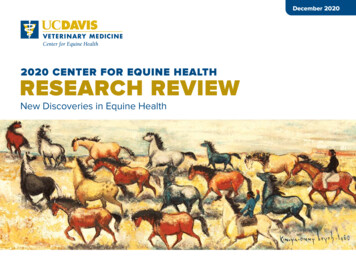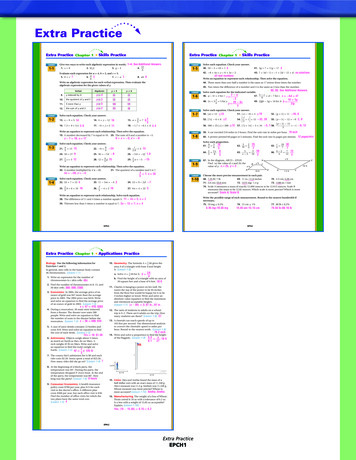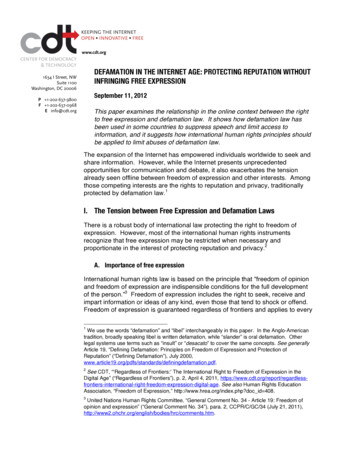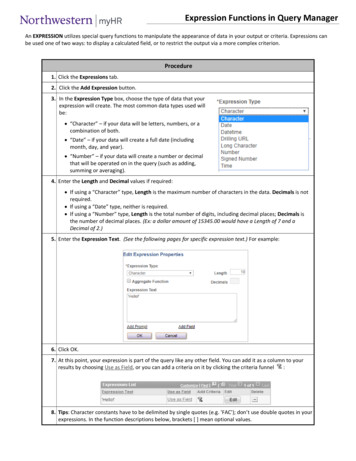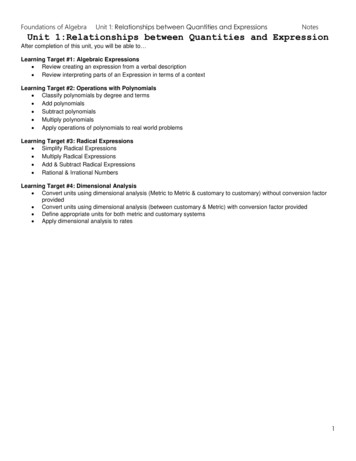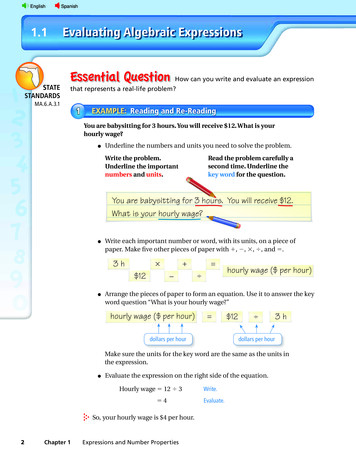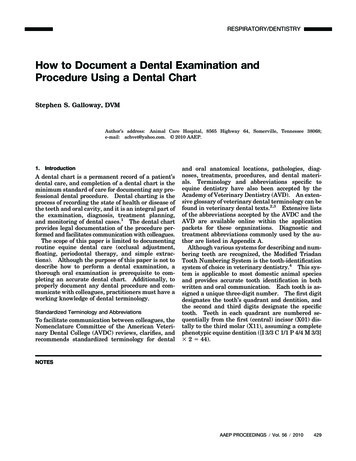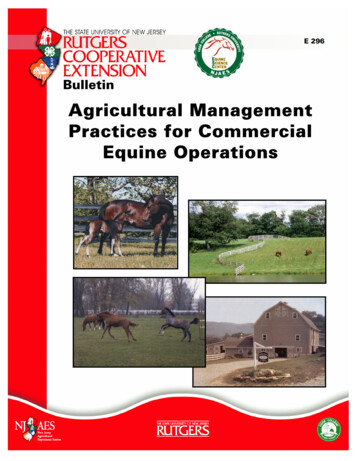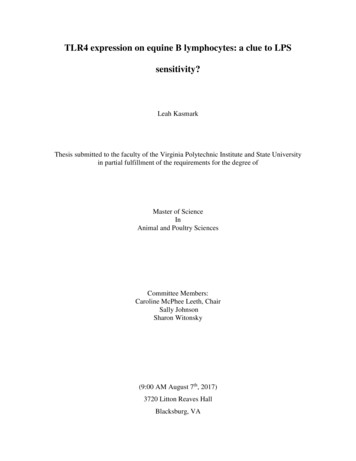
Transcription
TLR4 expression on equine B lymphocytes: a clue to LPSsensitivity?Leah KasmarkThesis submitted to the faculty of the Virginia Polytechnic Institute and State Universityin partial fulfillment of the requirements for the degree ofMaster of ScienceInAnimal and Poultry SciencesCommittee Members:Caroline McPhee Leeth, ChairSally JohnsonSharon Witonsky(9:00 AM August 7th, 2017)3720 Litton Reaves HallBlacksburg, VA
TLR4 expression on equine B lymphocytes: a clue to LPS sensitivity?Leah KasmarkAbstract for General PublicHorses are prone to potentially lethal infections due to their surrounding fecal containingenvironment and their predisposition to colic. Their gastrointestinal tract andenvironment naturally contain gram-negative bacteria such as E.coli. The gram-negativebacterial cell membrane expresses a molecule called lipopolysaccharide (LPS) which cancause inflammation by binding to an immune cell receptor called toll-like receptor 4(TLR4). In cases where epithelial barriers are compromised or breached, LPS has thepotential to enter the circulation and cause a severe inflammatory response capable ofprogressing to shock and death. Humans are also highly sensitive to LPS yet their Blymphocytes express non-functional TLR4. Mice, in contrast, are highly tolerant of LPSbut their B lymphocytes express functional TLR4. The objective of this study was todetermine TLR4 presence and functionality on equine B lymphocytes. Studies in horsehave perhaps been limited by the small number of antibody markers available for use inhorse. Two B lymphocyte markers not previously assessed in horse tissue were used inthis experiment to enrich for B lymphocytes. A TLR4 marker, also not previouslydescribed in the horse, was used in conjunction with the two B lymphocyte markersdetermined TLR4 is present on equine B lymphocytes. However, equine B lymphocytesfailed to proliferate in the presence of LPS similiar to human B cells. Transcriptionalchanges were observed in the equine cells in the TLR4 pathway upon treatment withLPS.
TLR4 expression on equine B lymphocytes: a clue to LPS sensitivity?Leah KasmarkScholarly AbstractHorses are prone to potentially lethal endotoxemia due to their surrounding fecalcontaining environment and their predisposition to colic. Their gastrointestinal tract andfeces naturally contain gram-negative bacteria. These bacteria express lipopolysaccharide(LPS) on their cell membranes, which is recognized by Toll-like receptor 4 (TLR4). Incases where epithelial barriers are compromised or breached LPS has the potential toenter circulation and cause the inflammatory symptoms seen with endotoxemia. Theobjective of this study was to determine TLR4 presence and functionality on equine Bcells. TLR4 expression on B lymphocytes has been studied in mouse, human and manyother mammals, but has not been well characterized in the horse. Humans are highlysensitive to LPS but their B cells express non-functional TLR4. Mice in contrast arehighly tolerant of LPS yet their B cells express functional TLR4. Studies in horse haveperhaps been limited by the limited array of antibody markers available for use in horse.Anti-human CD21 has previously been shown to mark equine B lymphocytes. We showrat anti-mouse CD45R(B220) mAbs also accurately labels equine B lymphocytes. Toinvestigate TLR4 expression in horses 12 Thoroughbred geldings, ages 5-10, were usedfor blood collection. By using the density gradient, Lympholyte, lymphocytes wereseparated from peripheral blood and incubated with or without LPS. B lymphocyteproliferation, TLR4 expression and mRNA changes were examined before or afterculture in the presence or absence of LPS. We demonstrate TLR4 is expressed on equineB lymphocytes through the use of a mouse anti-human TLR4 antibody, clone 76B357.1,not previously used in horse. We demonstrated equine B cells fail to proliferate underLPS challenge as opposed to highly proliferative mouse B lymphocytes. However,transcriptional changes were observed in the equine cells within the TLR4 pathway upontreatment with LPS.
AcknowledgementsThis thesis was accomplished with Dr. Caroline Leeth, who gave me theopprotunity to work with her and guided me throughout the entire study. I would also liketo thank my committee members Dr. Sally Johnson and Dr. Sharon Witonsky forcontributing their knowledge and expertise to the study. I am thankful for the graduatestudents in the Johnson and El-Kadi labs, especially Amanda Reeg and SydneyMcCauley, who graciously taught me lab techniques and gave their assistance wherever itwas needed. I also thank my parents who have supported, pushed and always encouragedme to be the best I could be.
Table of ContentsCHAPTER I: Introduction . 1References . .2CHAPTER II: Literature Review . 3Toll-like Receptors . . 3Overview of Toll-Like Receptor 4 . .5Human TLR4 expression . .7Mouse TLR4 expression . . .8Endotoxemia and Endotoxin Shock 8Conclusion . .9References .11CHAPTER III: TLR4 expression on equine B lymphocytes: a clue to LPSsensitivity? . 15Abstract . .15Introduction . 16Materials and Methods . .18Results . 23Summary and Conclusion .37Future Directions .38References . .40v
List of FiguresFigure 1: TLR4 signaling pathway .7Figure 2: TLR4, CD45R, and CD21 titrations .21Figure 3: Lympholyte and Ficoll-Paque Premium media slides 25Figure 4: Lymphocyte viability curve during in vitro culture . 26Figure 5a: Cell proliferation images of murine and equine lymphocytes treated with nostimulus, LPS, or CpG . .28Figure 5b: CellTrace Violet proliferation assay of murine and equine lymphocytes 29Figure 6a: TLR4, clone 76B357.1, expression on equine lymphocytes 31Figure 6b: CD45R (B220), clone RA-6B2, expression on equine lymphocytes .32Figure 6c: CD21, clone Bu33, and TLR4, clone 76B357.1, coexpression on equine Blymphocytes .33Figure 6d: CD45R (B220), clone RA-6B2, and TLR4, clone 76B357.1, coexpression onequine lymphocytes . .34Figure 7: Quantitative analysis of mRNA expression in equine lymphocytes with LPSstimulation and CpG stimulation . .35List of TablesTable 1: Presence of homologous TLR gene sequences .3Table 2: Real-time quantitative RT-PCR primer pairs .23Table 3: Lympholyte and Ficoll-Paque Premium media differences 24Table 4: Equine lymphocyte viability during in vitro culture .26vi
List of Definitions1. CD14-Cluster of differentiation 142. CD21-Cluster of differentiation 213. CD45R/B220-Cluster of differentiation 45 Receptor4. CpG-Cytosine triphosphate deoxynucleotide-Phosphodiester link-Guaninetriphosphate deoxynucleotide5. CT-Threshold cycle6. dsDNA-Double stranded deoxyribose nucleic acid7. GAPDH-Glyceraldehyde 3-phosphate dehydrogenase8. IL-1R-Interleukin 1 receptor9. IRF3-Interferon regulatory factor 310. IRF7-Interferon regulatory factor 711. IKKε-I-kappa-B kinase epsilon12. IRAK-Interleukin 1 receptor associated kinase13. IL-1β-Interleukin 1 beta14. IL-6-Interleukin 615. IL-10-Interleukin 1016. IFNβ- Interferon beta17. IP-10-Interferon gamma-induced protein 1018. LBP-Lipopolysaccharide binding protein19. LPS-Lipopolysaccharide20. MAPK-Mitogen activated protein kinase21. mCD14-Membrane CD14vii
22. MD-2-Lymphocyte antigen 9623. mRNA-Messenger ribonucleic acid24. MyD88-Myloid differentiation 8825. NF-κB-Nuclear factor-kappa-B26. PAMP-Pathogen associated molecular pattern27. PRR-Pattern recognition receptor28. RANTES-Regulated on Activation, Normal T Cell Expressed and Secreted29. RIP1-Receptor-interacting serine/threonine-protein kinase 130. TAK1-Transforming growth factor beta-activated kinase 131. TBK1-TANK-binding kinase 132. TLR-Toll-like receptor33. TIR-Toll/IL-1 Receptor34. TNFα-Tumor necrosis factor alpha35. TRAF-TNF receptor associated factor36. TRAM-Translocation associated membrane protein 137. TRIF-TIR domain-containing adaptor protein inducing interferon beta38. ssDNA-Single stranded deoxyribose nucleic acidviii
CHAPTER IIntroductionEndotoxemia is a prominent concern in human and equine medicine. Incomparison to other species, humans and horses experience an extreme inflammatoryresponse to lipopolysaccharide (LPS), the causative molecule in endotoxemia (Brade,1999). This syndrome can lead to lethal conditions such as septic shock, a sequelaaccounting for the majority of human deaths seen in U.S. hospitals (Liu, 2014). Found onall gram-negative bacteria, LPS can enter the body when any sort of breach in theepithelial tissue occurs (Moore, 1988). Since gram-negative bacteria can be readily foundin the environment and within the gastrointestinal tract of humans and equines thepotential for endotoxemia to occur is high.To be able to mount an immune reaction resulting in an inflammatory state, theLPS molecule must be recognized by the body. The recognition of LPS is achievedthrough Toll-like receptor 4 (TLR4)(Hoshino, 1999). TLR4 is located principally onimmune cells but can be found on other cell types such as liver and skeletal muscle(Frost, 2002; Takeda, 2004). TLR4 belongs to a family of receptors that function withinthe innate immune system (O’Neill, 2013). In most cases, when the body is exposed to aforeign antigen it will take up to 14 days to initiate a specific adaptive immune response(Werling, 2003; Ademokun, 2010). With receptors like TLR4, the body recognizescertain pathogens very quickly and mounts a response in a matter of hours to protect thebody (Janeway, 2005).The mechanism of recognition for LPS has been well documented in mouse andhumans, but is less characterized in horse (Vaure, 2014). Even though humans andequines are considered to be the most sensitive species to LPS, not many studies havebeen conducted to understand if this similarity can be seen at a molecular level.Understanding the differences and similarities between humans and equines could allowfor a more applicable animal model in human septic shock studies. This could open a lineof communication between human and veterinary medicine to search for furthertreatment options for both species. The objective of this study was to examine TLR4expression on equine B cells and their response to LPS treatment in vitro.1
ReferencesAdemokun, A. A., and D. Dunn-Walters. 2010. Immune Responses: Primary andSecondary. eLS.Brade, H. 1999. Endotoxin in health and disease. Marcel Dekker, New York.Frost, R. A., G. J. Nystrom, and C. H. Lang. 2002. Lipopolysaccharide regulatesproinflammatory cytokine expression in mouse myoblasts and skeletal muscle.American journal of physiology. Regulatory, integrative and comparativephysiology 283: R698-709.Hoshino, K. et al. 1999. Cutting Edge: Toll-Like Receptor 4 (TLR4)-Deficient Mice AreHyporesponsive to Lipopolysaccharide: Evidence for TLR4 as the Gene Product.The Journal of Immunology 162: 3749-3752.Janeway, C. 2005. Immunobiology: The immune system in health and disease 6th ed.Garland Science, New York.Liu, V. et al. 2014. Hospital deaths in patients with sepsis from 2 independentcohorts. Jama 312: 90-92.Moore, J. N. 1988. Recognition and treatment of endotoxemia. The Veterinary clinics ofNorth America. Equine practice 4: 105-113.O'Neill, L. A., D. Golenbock, and A. G. Bowie. 2013. The history of Toll-like receptors redefining innate immunity. Nature reviews. Immunology 13: 453-460.Takeda, K., and S. Akira. 2004. TLR signaling pathways. Seminars in immunology 16: 39.Vaure, C., and Y. Liu. 2014. A comparative review of toll-like receptor 4 expression andfunctionality in different animal species. Frontiers in immunology 5: 316.Werling, D., and T. W. Jungi. 2003. TOLL-like receptors linking innate and adaptiveimmune response. Veterinary immunology and immunopathology 91: 1-12.2
CHAPTER IIReview of LiteratureToll-like ReceptorsThe surge in discovery of Toll-like receptors (TLRs) can be traced back to theCold Spring Harbor Symposia on Quantitative Biology in 1989, where Charles Janeway,Jr. proposed that there were nonclonal origins to the immune system yet to becharacterized. He hypothesized that innately conserved receptors existed and couldrecognize pathogen-associated molecular patterns (PAMPs) of non-host origin andtermed these receptors pattern recognition receptors (PPRs) (Janeway, 1989). Althoughthere are a many types of PPRs, TLRs are one of the most studied of the group. The firstTable 1: Presence of homologous TLRgene sequences.of the Toll family was cloned in mice and calledthe Interleukin-1 Receptor (IL-1R), but at thatHumanMouseHorsetime the mechanism of the receptor was unknownTLR1YesYesYes(Sims, 1988). In 1989, the IL-1R was cloned inTLR2YesYesYeshuman T lymphocytes with still no understandingTLR3YesYesYesof its mechanism (Sims, 1989). During the sameTLR4YesYesYesperiod, the Toll gene was characterized inTLR5YesYesNoDrosphila melanogaster and found to be involvedTLR6YesYesYesin the dorso-ventral axis formation in the fly’sTLR7YesYesYesembryo (Hashimoto, 1988). A few years later theTLR8YesNonfunctionalYesIL-1R and Toll genes were found to haveTLR9YesYesYesTLR10YesNoYes4 more members of the Toll family (TLR1-5)TLR11NoYesNowere identified in human and the group wasTLR12NoYesNorenamed Toll-like receptors (Rock, 1998).TLR13NoYesNohomologous domains, leading to the hypothesis ofa shared signal transduction (Gay, 1991). In 1998,To date, 13 TLRs have been identified. Ofthese TLR genes 10 of the TLR genes areexpressed in humans and 12 are expressed in3
mice. Some species differences exist for TLR expression (Table 1). For example TLR1TLR9 are conserved between human and mice, however TLR10 is not expressed in mice.In addition TLR11-TLR13 are not found in humans, but are present in mice (Kawai,2009). Each identified TLR has a unique structure which results in the recognition ofunique ligands. Akira and collegues (1999) created several Tlr and adapter moleculeknockout mice that elucidated many TLR ligands. The human homologue of DrosophilaToll, hToll also known as TLR4, was the first of these Tlr knockout mice created andconfirmed Lipopolysaccharide (LPS) as the TLR4 ligand (Hoshino, 1999).The following is a summary of TLRs and their known ligands. TLR2, which isable to heterodimerize with TLR1 or TLR6, can recognize triacetylated lipoproteins anddiacetylated lipoproteins respectively (Takeuchi, 2001; Takeuchi, 2002). TLR2–/– andTLR1–/– murine cells were needed to recognize and respond to triacetylated lipoproteins.( Takeuchi, 2002). It was shown that murine TLR6–/– cells were unresponsive todiacetylated lipoproteins, but were responsive to other lipoproteins. In cojunction, TLR2–/–TLR6–/– embryonic fibroblasts were unresponsive to diacetylated lipoproteinsdemonstrating TLR2 and TLR6 are imparative for diacetylated lipoprotein recognition(Takeuchi, 2001). TLR3 is able to aid in the defense against viral infections by sensingdouble stranded DNA (dsDNA). A TLR3–/– mouse was observed to have reducedresponses and cytokine production to polyinosine–polycytidylic acid, a synthetic analogof dsDNA (Alexopoulou, 2001). Flagellin, an inherent component of bacterial flagella,can be recognized by TLR5. This was confirmed using tandem mass spectrometry,analyzing Listeria monocytogenes culture supernatants, which identified the bacterialflagella as having the highest level of TLR5-stimulating activity (Hayashi, 2001). Asynthetic group of molecules called imidazoquinolines activate immune cells and arerecognized by TLR7. Although, it was known that imidazoquinolines had strong antiviral and anti-bacterial properties, it was not understood how until Hemmi et al.demonstrated that TLR7–/– mouse cells produced no protective responses afterimidazoquinolines treatment (Hemmi, 2002). TLR7, along with TLR8, also recognizessingle stranded DNA (ssDNA), which was observed using TLR7- and TLR8- deficientmurine cells (Heil, 2004). Although, TLR8 is non-functional in mice, transgenic micewere developed to express human TLR8 in order to uncover its ligand (Kugelberg, 2014).4
TLR9 provides anti-viral immunity. It was demonstrated that unmethalated CpGdinucleotides, common in bacterial DNA, activated TLR9 when TLR9 deficint murinecells were unresponsive to CpG DNA (Hemmi, 2000). TLR10 is the only TLR with anunidentified ligand, but demonstrated anti-inflammatory effects. This was observed in theincrease of proinflammatory cytokine release after blocking TLR10 during stimulation(Oosting, 2014). TLR11, which is highly expressed in kidney and bladder tissue, is as akey defense against uropathogenic bacteria. TLR11-deficient mice failed to recognizeand respond to uropathogenic E. coli (Zhang, 2004). This TLR also oligomerizes withTLR12 to recognize and respond against Toxoplama gondii infection, which wasobserved when transfection of both TLR11 and TLR12 was needed for murinemacrophages to produce high levels of IL-12 (Andrade, 2013). Finally, TLR13 was showto recognize ribosomal RNA from bacteria (Oldenburg, 2012).Overview of Toll-Like Receptor 4TLR4 is among one of the most studied TLRs and is known to play an intricaterole in eliciting the symptoms seen in endotoxemia and sepsis in many species. TLR4was orginally identified as hToll as it resembled Drosophila melangaster’s Toll(Medzhitov, 1997). A year later, a group of 4 related receptors were found in humansand the group was renamed Toll-like receptors (Rock, 1998). At TLR4’s discovery nofunction was known, but it was hypothesized this TLR would function with the innateimmune system similar to Toll in D. melangaster (Lemaitre, 1996). It was discovered thattwo mouse strains, C3H/HeJ and C57BL/10ScCr, had defective lipopolysaccharide (LPS)signaling that corresponded with mutations in the TLR4 gene (Poltorak, 1998). Akira etal. (1999), produced a TLR4 knockout mouse that failed to respond to LPS, verifyingLPS as the TLR4 ligand (Hoshino, 1999). It was observed that after TLR4 cDNAtransfection, LPS responsiveness was undetected thus, it was hypothesized that TLR4 didnot directly bind LPS (Kirschning, 1998; Wright, 1999). Myloid differentiation factor 2(MD-2) was discovered as the key link between LPS and TLR4 to allow recognition(Shimazu, 1999).In addition to MD-2, TLR4 uses several other molecules to recognize LPS. BeforeLPS can be bound by the TLR4 complex, Lipopolysaccaride binding protein (LBP) binds5
LPS in the serum (Tobias, 1989). LBP then transfers LPS to another accessory protein,membrane CD14 (Park, 2009). Membrane CD14 (mCD14) is a glycoprotein that isanchored in the cellular membrane and transfers LPS to the TLR4-MD-2 complex forrecognition and signal transduction (Wright, 1990).After TLR4 binds to LPS on the cell surface through MD-2 interaction, theintracellular domain of two TLR4 proteins called the Toll/IL-1R (TIR) domainhomodimerize (Kawai, 2009; Vaure, 2014). TLR4 is able to signal through two adaptermolecules, Myloid differentiation factor 88 (Myd88) and TIR-domain-containingadapter-inducing interferon-β (TRIF), resulting in two distinct signal cascades (Takeda,2004; Figueiredo, 2009; Kawai, 2009). The recruitment of MyD88 results in theactivation of MAP kinases (MAPKs) and Nuclear Factor Kappa B (NF-κB) that controlsinflammatory cytokine gene expression. TRIF recruitment activates MAPKs and NF-κBas well, along with interferon regulatory factor 3 (IRF3), which leads to the production oftype I interferons (Kawai, 2007).6
Figure 1: TLR4 signaling pathways.Human TLR4 expression on immune cellsTLR4 expression varies between cell types and between species. TLR4expression is higher in myloid derived cells compared to lymphoid dervied cells. Inhuman samples, monocytes were found to produce high levels of TLR4 mRNA, incontrast to T cells, natural killer cells, and plasmacytoid dendritic cells that show little to7
no TLR4 mRNA (Hornung, 2002; Ketloy, 2008). Human B cells express low, butdefinite levels of TLR4 mRNA. Human B cells are non-responsive to LPS (Hornung,2002; Peng, 2005; Ketloy, 2008). B cell responsiveness to LPS can be induced through invitro co-treatment with IL-4 in humans (Mita, 2002).Mouse TLR4 expression on immune cellsSimilar to humans, murine TLR4 expression is higher in myloid derived cellscompared to lymphoid dervied cells. In contrast to human, murine plasmacytoid dendriticcells express high levels of TLR4 (Ketloy, 2008). In addition, TLR4 mRNA was presentin higher quantities in murine B cells and T cells than seen in humans (Iwami, 2000;Gururajan, 2007). TLR4 on murine B cells acts contrary to the subfunctional TLR4 foundon human B cells. Murine B cell TLR4 is able to recognize LPS to initiate signaltransduction that leads to B cell proliferation, cytokine production, and class-switchrecombination (Xu, 2008; Stavnezer, 2014). Differences in TLR4 expression andfunctionality become of interest when studying disease states related to LPS such asendotoxemia and septic shock. When picking a model to perform studies, understandingspecies differences will lead to accurate and applicable data (Vaure, 2014).Endotoxemia and SepsisEndotoxemia and the further development of sepsis is a leading cause of death inboth humans and equines. Sepsis is estimated to cause 250,000 human deaths annually inthe U.S. (Tidswell, 2011). Septic shock patients positive for endotoxemia experience ahigher mortality rate than those who did not have endotoxemia (Danner, 1991). The deathtoll of endotoxemia is hard to quantify in horses, but since it plays a role in thepathogenesis of many gastrointestinal diseases such as colic and neonatal septicemia, it isconsidered a principal killer in equines (Morris, 1991).Endotoxin, also known as LPS, is expressed in all Gram negative bacteria. LPS,which is structurally necessary for the bacterial outer membrane, is composed of a lipid Aregion, core section, and an O-polysaccaride. Positioned to the inside of the membrane,the hydrophobic lipid A region is the endotoxically active portion of the molecule(Erridge, 2002). As Gram-negative bacteria proliferate or die, LPS is released from the8
membrane into the surrounding microenvironment (Morris, 1991). This becomes aconcern in gastrointestinal and inflammatory diseases that compromise the epithelialbarrier and allow LPS to enter bodily tissues and circulation from the gastrointestinaltract (Moore, 1979). In a healthy individual, LPS can be cleared from the circulation bythe liver, however in compromised or persistent cases, LPS may reach damaging levels(Herring, 1963; Satoh, 2008). Once in the circulation the pro-inflammatory mediatorsreleased in response to LPS can cause systemic inflammation, which can lead to organfailure and death (Brandtzaeg, 1989).ConclusionDuring the last 20 years there has been a burgoning interest in toll-like receptorsamoung different species and their function in the immune system. Research has includedmany species, however most attention has been paid to mouse and human TLRs. Formedical reasons, human TLRs are of higher relevence, although mouse TLRs are oftenused and studied to model human function.TLRs are a group of highly conserved receptors that function as a facet of ourinnate defense against pathogens. In many species, these TLRs are located on and withinmany different cell types where they are able to recognize common patterns presented bypathogens. Recognition of a specific PAMP will cause a conformation change in theTLR. This change induces the recruitment of adapter molecules, which signal tointermediate proteins and finally leads to the production of cytokine NF-κB and type-Iinterferons. Theses cytokines result in the attraction of immune cells to the threatenedarea to neutralize and remove pathogens. Understanding the activity of TLRs canpossibly indicate ways to manipulate disease states. Currently, TLR ligands are used asadjuvants with some vaccines to increase the bodies immune response to subsequentlyincrease the effectiveness of the vaccine (Steinhagen, 2011).TLR4 was one of the first TLRs discovered and fit the PRR hypothesis. TLR4recognizes LPS, a potent TLR ligand, that is presented on gram-negative bacteria. WhenLPS is present in the circulation it is considered endotoxemia, which corresponds to anincrease in lethality amoung sepsis patients. Humans have a high systemic inflammatoryresponse to LPS as do equines, mice have a lower inflammatory response. Therefore, the9
equine TLR4 may be more comparable to human TLR4. Studies investigating the speciesdifferences and similarities between human, horse and mouse in regards to TLR4expression may give rise to a more applicable human model to study diseases involvingLPS. Hopefully, research in this area will lead to the development of new and effectivetreatment options for humans and equines.10
ReferencesAlexopoulou, L., A. C. Holt, R. Medzhitov, and R. A. Flavell. 2001. Recognition ofdouble-stranded RNA and activation of NF-kappaB by Toll-like receptor 3.Nature 413: 732-738.Anderson, K. V., L. Bokla, and C. Nusslein-Volhard. 1985. Establishment of dorsalventral polarity in the Drosophila embryo: the induction of polarity by the Tollgene product. Cell 42: 791-798.Andrade, W. A. et al. 2013. Combined action of nucleic acid-sensing Toll-like receptorsand TLR11/TLR12 heterodimers imparts resistance to Toxoplasma gondii inmice. Cell host & microbe 13: 42-53.Brade, H. 1999. Endotoxin in Health and Disease. Marcel Dekker, New York.Brandtzaeg, P. et al. 1989. Plasma Endotoxin as a Predictor of Multiple Organ Failureand Death in Systemic Meningococcal Disease. The Journal of InfectiousDiseases 159: 195-204.Danner, R. L., R. J. Elin, J. M. Hosseini, R. A. Wesley, J. M. Reilly and J. E. Parillo .1991. Endotoxemia in Human Septic Shock. Chest 99: 169-175.Erridge, C., E. Bennett-Guerrero, and I. R. Poxton. 2002. Structure and function oflipopolysaccharides. Microbes and infection 4: 837-851.Figueiredo, M. D., M. L. Vandenplas, D. J. Hurley, and J. N. Moore. 2009. Differentialinduction of MyD88- and TRIF-dependent pathways in equine monocytes byToll-like receptor agonists. Veterinary immunology and immunopathology 127:125-134.Gay, N. J., and F. J. Keith. 1991. Drosophila Toll and IL-1 receptor. Nature 351: 355356.Gururajan, M., J. Jacob, and B. Pulendran. 2007. Toll-like receptor expression andresponsiveness of distinct murine splenic and mucosal B-cell subsets. PloS one 2:e863.Hashimoto, C., K. L. Hudson, and K. V. Anderson. 1988. The Toll gene of drosophila,required for dorsal-ventral embryonic polarity, appears to encode atransmembrane protein. Cell 52: 269-279.Hayashi, F. et al. 2001. The innate immune response to bacterial flagellin is mediated byToll-like receptor 5. Nature 410: 1099-1103.Heil, F. et al. 2004. Species-specific recognition of single-stranded RNA via toll-likereceptor 7 and 8. Science 303: 1526-1529.11
Hemmi, H. et al. 2000. A Toll-like receptor recognizes bacterial DNA. Nature 408: 740745.Hemmi, H. et al. 2002. Small anti-viral compounds activate immune cells via the TLR7MyD88-dependent signaling pathway. Nature immunology 3: 196-200.Herring, W. B., J. C. Herion, R. I. Walker, and J. G. Palmer. 1963. Distribution andclearance of circulating endotoxin. The Journal of clinical investigation 42: 79-87.Hornung, V. et al. 2002. Quantitative expression of toll-like receptor 1-10 mRNA incellular subsets of human peripheral blood mononuclear cells and sensitivity toCpG oligodeoxynucleotides. Journal of immunology 168: 4531-4537.Hoshino, K. et al. 1999. Cutting Edge: Toll-Like Receptor 4 (TLR4)-Deficient Mice AreHyporesponsive to Lipopolysaccharide: Evidence for TLR4 as the Gene Product.The Journal of Immunology 162: 3749-3752.Ireton, G. C., and S. G. Reed. 2013. Adjuvants containing natural and synthetic Toll-likereceptor 4 ligands. Expert review of vaccines 12: 793-807.Iwami, K. I. et al. 2000. Cutting edge: naturally occurring soluble form of mouse Tolllike receptor 4 inhibits lipopolysaccharide signaling. Journal of immunology 165:6682-6686.Janeway, C. A., Jr. 1989. Approaching the asymptote? Evolution and revolution inimmunology. Cold Spring Harbor symposia on quantitative biology 54 Pt 1: 1-13.Johnson, D. A. 2013. TLR4 agonists as vaccine adjuvants: a chemist's perspective. Expertreview of vaccines 12: 711.Kawai, T., and S. Akira. 2007. TLR signaling. Seminars in immunology 19: 24-32.Kawai, T., and S. Akira. 2009. The roles of TLRs, RLRs and NLRs in pathogenrecognition. International immunology 21: 317-337.Ketloy, C. et al. 2008. Expression and function of Toll-like receptors on dendritic cellsand other antigen presenting cells from non-human primates. Veterinaryimmunology and immunopathology 125: 18-30.Kirschning, C. J., H. Wesche, T. Merrill Ayres, and M. Rothe. 1998. Human toll-likereceptor 2 confers responsiveness to bacterial lipopolysaccharide. The Journal ofexperimental medicine 188: 2091-2097.Kugelberg, E. 2014. Innate immunity: Making mice more human the TLR8 way. NatureReviews.Immunology 14(1): 6.12
Lemaitre, B., E. Nicolas, L. Michaut, J. M. Reichhart, and J. A. Hoffmann. 1996. Thedorsoventral regulatory gene cassette spatzle/Toll/cactus controls the potentantifungal response in Drosophila adults. Cell 86: 973-983.Medzhitov, R., P. Preston-Hurlburt, and C. A. Janeway, Jr. 1997. A human homologue ofthe Drosophila Toll protein signals activation of adaptive immunity. Nature 388:394-397.Mita, Y. et al. 2002. Toll-like receptor 4 surface expression on human monocytes and Bcells i
Janeway, C. 2005. Immunobiology: The immune system in health and disease 6th ed. Garland Science, New York. Liu, V. et al. 2014. Hospital deaths in patients with sepsis from 2 independent cohorts. Jama 312: 90-92. Moore, J. N. 1988. Recognition and treatment of endotoxemia. The Veterinary clinics of North America. Equine practice 4: 105-113.
